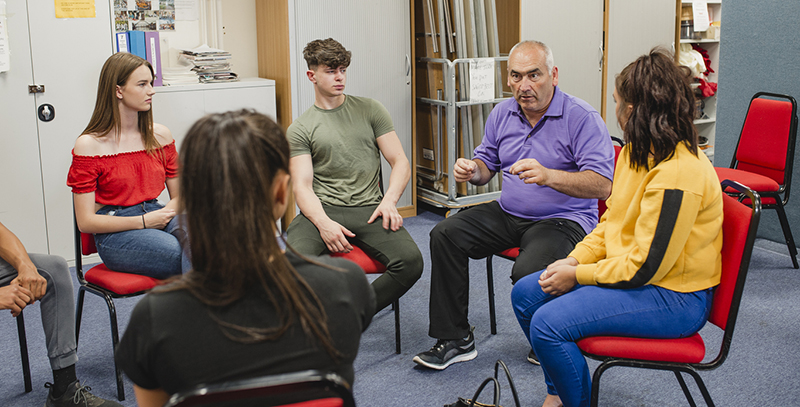We've put together a number of scenarios featuring fictional situations and people to show how our guidance could be used in social work practice.
Use our guidelines and quality standards to find specific recommendations to support your professional judgement in your everyday work.
View examples for principal social workers
Families and relationships settings
Featured scenario: developing relationships with parents
A social worker makes a home visit to a family following concerns of neglect highlighted by the school. Katie, the mother, becomes angry with the social worker. She feels that they are interfering and have no right to be there asking such personal questions when she's no worse than other mums she knows.
Action
The social worker remembers a group supervision session which covered content from the child abuse and neglect guideline, including ways to build relationships with parents. She explains more clearly to Katie the legal context for her visit. This helps to depersonalise the situation and makes Katie feel more informed.
Further guidance
The guidance includes advice to be open and honest when working with parents, including sharing the legal context in which they are involved.
More scenarios and resources
Scenario 2: involving families in care planning
Chloe, 14, has a history of self-harm. She has recently been admitted to an inpatient mental health unit following an overdose. Chloe lives with her dad, Jakob. Jakob works night shifts and relies on public transport. He complains to Chloe’s social worker that he has not been involved in any care planning discussions since Chloe has been admitted.
Action
Chloe’s social worker uses guidance on transition between inpatient mental health settings and community or care home settings to show staff on the ward the importance of supporting and involving families. The social worker is able to persuade the psychiatric team to arrange meetings at different times to fit with Jakob’s working pattern and reliance on public transport.
More information
The guidance includes advice on building relationships with and supporting families, parents and carers throughout admission.
Scenario 3: supporting inter-generational need
Farzana, 13, is blind, has a moderate learning disability and is experiencing depression following the loss of her father. Farzana’s mum, Shazia, has said how worried she is about Farzana. She also says that she feels overwhelmed as she is a carer for her own mother, who has dementia and lives with them in the family home.
Action
Farzana’s social worker uses guidance on depression in children and young people to feel assured that Farzana is being offered appropriate support for her depression. They also use guidance on assessment, management and support for people living with dementia and their carers to help prepare for a sensitive discussion with Shazia about her needs. Following the discussion Shazia agrees to a carer’s assessment and information about how her mother could be supported by adult services.
More information
The guidance includes advice about the recognition and management of depression in children and highlights that people who live with a person with dementia could be at an increased risk of depression.
Relevant resources
Guidelines
- Children's attachment guideline
- Child abuse and neglect guideline
- Harmful sexual behaviour among children and young people guideline
- Looked-after children and young people guideline
- Social and emotional wellbeing in primary education guideline
- Social and emotional wellbeing in secondary education guideline
- Transition between inpatient mental health settings and community or care home settings guideline
- Depression in children and young people guideline
Quality standards

Mental health services
Featured scenario: managing violence and aggression
Alice, 14, has mental health issues. She lives with her dad and has regular breaks in a residential children’s home. The home informs Alice’s dad of any incidents where Alice has hit staff or young people. Alice tells her dad that when this happens, she is not allowed to phone him afterwards and this upsets her.
Action
Alice’s social worker uses guidance on the short-term management of violence and aggression in mental health, health and community settings to plan a review meeting with Alice, her dad and the care home manager. The plan includes good practice in terms of not using restrictions on contacting family as a punishment.
Further guidance
The guidance includes recommendations on de-escalation and appropriate restrictive interventions for children and young people.
More scenarios and resources
Scenario 2: maintaining contact with service users
A team leader of an integrated mental health team has identified that young men referred to their service with both mental health and substance use issues are twice as likely to stop attending appointments.
Action
The team leader uses guidance on coexisting severe mental illness and substance use: community health and social care services to develop a proposal for local research to find out why this group of people stop attending the service. They make the case that the research could be used to change the service, making it more effective in meeting the needs of men with mental health and substance use issues.
More information
The guidance includes advice on service design for managers and organisations and specific guidance on maintaining contact with individual people accessing support.
Scenario 3: advance planning and psychiatric inpatient admission
Joanne has a moderate learning disability and has experienced 2 psychotic episodes. The second time she was admitted to a psychiatric inpatient unit. Joanne was recently discharged, but she and her family are worried that this might happen again and they don’t know what to do.
Action
Joanne’s social worker refers to guidance on mental health problems in people with learning disabilities and transition between inpatient mental health settings and community in a request to colleagues in learning disability and psychiatric teams to meet with Joanne and her family. The purpose of the meeting would be to create a crisis plan, which would include advance decisions about treatment and support and potential triggers or indicators of crisis.
More information
The guidance includes advice on developing a mental health care plan for people with a learning disability, crisis planning, and involving and supporting family and carers.
Relevant resources
-
Guidelines
- Depression in adults guideline
- Depression in children and young people guideline
- Service user experience in adult mental health guideline
- Decision-making and mental capacity guideline
- Coexisting mental illness and substance misuse guideline
- Mental health of adults in the criminal justice system guideline
- Transition between inpatient mental health settings and community or care home settings guideline
- Antisocial behaviour in children guideline
Quality standards
- Depression in adults quality standard
- Depression in children and young people quality standard
- Mental health of adults in the criminal justice system quality standard
- Transition between inpatient mental health settings and community or care home settings quality standard
- Antisocial behaviour in children quality standard

Learning disability settings
Featured scenario: supporting parents
Raphael, 10, has a severe learning disability and autism. He has no sense of danger, frequently hits his head on the wall and needs one-to-one support from his parents during waking hours. His parents are exhausted and feel isolated. They don’t know what they should do when he becomes distressed and hurts himself.
Action
Raphael’s social worker contacts colleagues in the local autism team to make a case for additional support for the family. The social worker refers to guidance on learning disabilities and behaviour that challenges and autism spectrum disorder in under 19s in the email, highlighting the value that the additional support would offer the family.
Further guidance
The guidance includes advice on the provision of short breaks and access to advice and ongoing support for families and carers.
More scenarios and resources
Scenario 2: planning for the future
William, 53, lives with his mother Elsie, 82. William has Down’s syndrome and a mild learning disability. Elsie is worried about how William will cope when she dies. William wants to continue living in the family home. He would also like to learn how to fish and to visit Blackpool on holiday.
Action
William’s social worker refers to guidance on the care and support of people growing older with learning disabilities and the quick guide on person-centred future planning in a review meeting with William and Elsie. They use the quick guide as a basis for starting to discuss and create a future plan with William.
More information
The guidance includes information about person-centred planning for the future, involving family and carers if appropriate, and considering needs such as housing and future wishes.
Scenario 3: providing end of life care and support
Rainey has a moderate learning disability and was recently diagnosed with terminal bowel cancer. Rainey is frightened of dying and wants to leave hospital as soon as possible. Rainey’s consultant advises that she may only have up to 2 weeks to live.
Action
Rainey’s social worker uses guidance on the care and support of people growing older with learning disabilities and care of dying adults in the last days of life to help plan an agenda for an urgent multi-disciplinary care planning meeting. They use the guidance to ensure that Rainey’s wishes and concerns are given priority and to ensure that the care and support provided is seamless.
More information
The guidance includes recommendations on person-centred end of life care planning and communication needs, including the opportunity to discuss fears and anxieties.
Relevant resources
Guidelines
- Learning disabilities and behaviour that challenges - service design and delivery guideline
- Challenging behaviour and learning disabilities - prevention and interventions guideline
- Care and support of people growing older with learning disabilities guideline
- Transition from children’s to adults’ services guideline
- Decision-making and mental capacity guideline
- Mental health problems in people with learning disabilities guideline
- Autism spectrum disorder in under 19s guideline
- Autism spectrum disorder in adults guideline
Quality standards

Services for older people
Featured scenario: discharging people from hospital
During supervision, a hospital social worker discusses the pressure they are feeling to discharge people to care homes when those people may not have the capacity to make a decision about where they live. The social worker feels this potentially conflicts with the Mental Capacity Act 2005, particularly the principle of seeking the least restrictive option.
Action
The supervisor advises the social worker to use specific recommendations from guidance on transition between inpatient hospital settings and home and decision-making and mental capacity to strengthen their professional power when discussing discharge planning with health colleagues, including informing best interest meetings.
Further guidance
The guidance recommends that decisions about long-term care are not made whilst in crisis and that decisions are made in the person's best interests.
More scenarios and resources
Scenario 2: taking a person-centred approach to rehabilitation
Adio enjoys meeting his friends at a local Jamaican café, where he eats his main meal of the day. However since having a stroke Adio lacks the confidence to leave the house. Adio’s daughter has noticed that he has lost weight and that he seems depressed.
Action
The social worker meets with Adio, who confirms that he misses his friends and Jamaican food. Adio’s social worker uses guidance on people’s experience of adult social care and stroke rehabilitation in adults to plan a discussion with the occupational therapist in the stroke rehabilitation team. Following the discussion there is agreement that visiting the café will be included as a goal in the plan.
More information
The guidance recommends that each person’s self-defined preferences and needs should be used as the basis for care and that stroke rehabilitation plans should include goals that are meaningful for the person.
Scenario 3: improving wellbeing in care homes
A practice educator asks a first year social work student to write a critical reflection on how they review care and support for older people in care homes. The student knows that wellbeing is key to the Care Act 2014, but is struggling to understand what this means in practice.
Action
The student uses the quality standard on mental wellbeing of older people in care homes and the quick guide on promoting positive mental wellbeing for older people to help understand what contributes to positive mental wellbeing in care homes. They conclude that they will use each quality statement to check care records in future reviews that they undertake in care homes.
More information
The guidance includes statements describing support that improves mental wellbeing in care home settings, such as participation in meaningful activity and maintaining and developing personal identity.
Relevant resources
Guidelines
- Older people's independence and wellbeing guideline
- Managing medicines in care homes guideline
- Managing medicines for adults receiving social care in the community guideline
- Older people and multiple long-term conditions guideline
- People's experience in adult social care guideline
- Dementia guideline
- Care of dying adults guideline
- Home care guideline
- Decision-making and mental capacity guideline
Quality standards
- Older people's independence and wellbeing quality standard
- Medicines management in care homes quality standard
- Medicines management for people receiving social care in the community quality standard
- Older people and multiple long-term conditions quality standard
- People's experience in adult social care quality standard
- Dementia quality standard
- Care of dying adults quality standard
- Home care quality standard
About these examples
We've produced these example scenarios to help social workers understand how to use our guidelines and quality standards.
Our guidelines focus on a particular topic or setting and provide a comprehensive set of recommendations for action.
Our quality standards focus on areas of variation in practice and can be used to measure improvement or demonstrate good quality.
